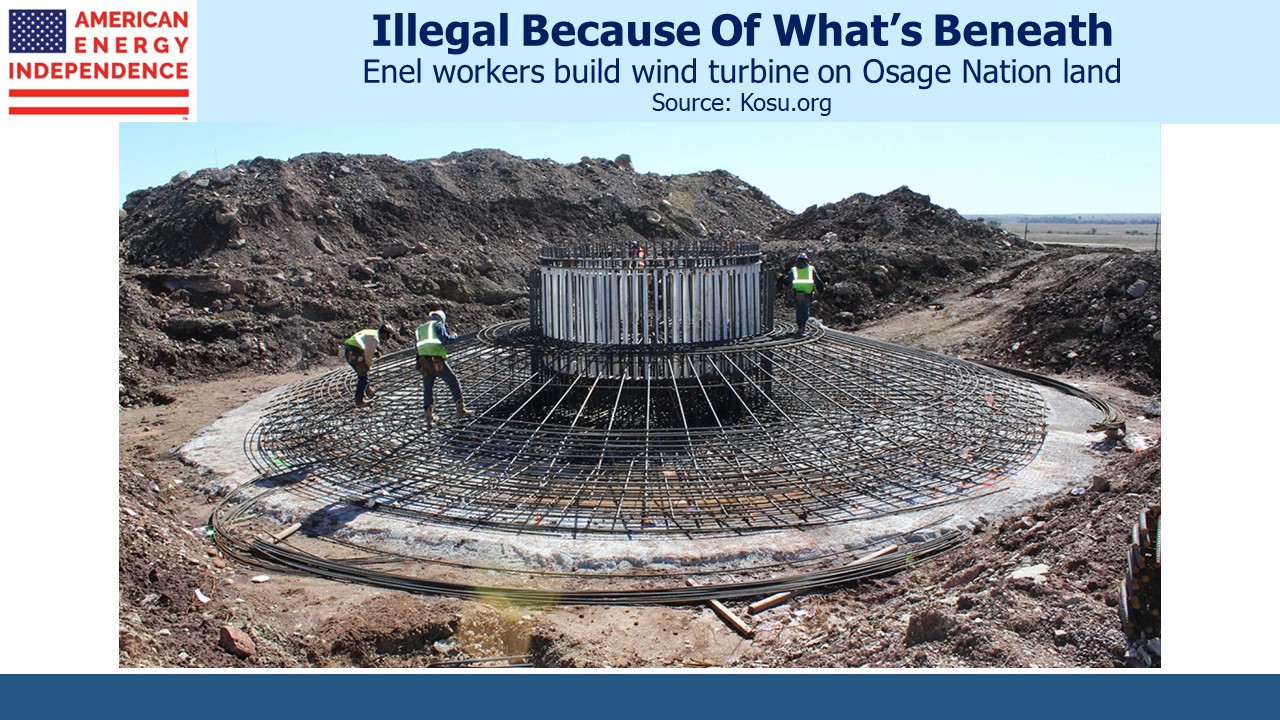Windpower Stumbles On Unique American Mineral Rights
The US is unique in that sub-surface mineral rights typically belong to the landowner. In every other country we’ve looked at, ultimately the government is the owner of what’s beneath you. This was a crippling feature of the failed effort by driller Cuadrilla to produce natural gas using US fracking technology in Yorkshire, north England (see British Shale Revolution Crushed: America’s Unique Ownership of Oil and Gas).
Because the local community didn’t have any ownership and therefore no royalties on output, the disruption and noise that accompany fracking became a political issue. It was perceived as the government exploiting regular people, even though Britain could use more natural gas of its own.
Caudrilla gave up.
The Osage Nation recently won a famous court victory over Italian “green energy” company Enel when a judge found that 84 wind turbines had been illegally installed on Osage land and ordered their removal.
Litigation had been going on for a decade, but ultimately the case turned on whether Enel had been mining when they dug up and crushed rock to create the foundations for their wind turbines. The Osage Allotment Act of 1906 awarded subsurface mineral rights to the Osage Nation.
We know much more about Osage thanks to David Grann’s 2017 book Killers of the Flower Moon, now also a movie. The story of how their rights to crude oil were violated almost a century ago through numerous murders perhaps makes them a more energetic legal adversary.
Enel argued that digging up and crushing rock did not constitute interfering with the “minerals estate”. They argued that they had temporarily trespassed, and offered to pay damages of $69K.
This argument suffered a setback when the court was shown a video of dynamite being used to dislodge the rock.
Enel estimates that removing the turbines will cost $300 million. There will also be another trial to determine Enel’s liability for damages over the past decade.
A good summary of the story can be found here.
The Osage Nation ultimately won their case because Enel violated their ownership of the mineral rights that came with the land. In another country they would be separated, but in America you own what’s beneath you “to the center of the earth” as Enel’s lawyer conceded in court.
This is the third time a Federal judge has ordered the removal of wind turbines.
In 2018 a judge ordered three turbines to be removed in Iowa. In 2022 Falmouth, Massachusetts was ordered to remove two turbines.
People who live close to these structures tend to complain about the noise. They’ve been compared to helicopters, and one Vietnam vet said it triggered traumatic memories of combat.
Homeowners on the New Jersey shore won a big victory when Danish wind turbine maker Orsted gave up on plans to build dozens of turbines (see Environmentalists Opposed To Windpower).
Other countries have seen similar legal battles. Two years ago an Australian court ordered 52 wind turbines to shut down at night in response to a lawsuit from neighbors complaining about noise. In 2016 a French court ordered seven turbines be removed because of the threat they posed to golden eagles.
Meanwhile that wretched little girl Greta has shown that a singular focus on climate change is complicated. She recently protested in Norway against wind turbines that were located on reindeer pastures, which she said “violated the human rights” of the indigenous Sami people who farm there.
Perversely, liberals are often accused of trampling over the environment in their pursuit of renewables, while conservatives are the ones fighting to preserve nature as it is. This was most clear in the opposition lined up against Orsted by residents of the Jersey shore, which is solidly the red part of a very blue state. Critics of the proposed windfarm cited danger to sealife. The construction of renewables infrastructure is often in underpopulated areas because solar and wind have a much bigger footprint than conventional power plants. This is turning the traditional environmentalism normally associated with Democrats on its head.
For years energy infrastructure projects have struggled with legal delays. Climate extremists have discovered how to weaponize the court system very effectively. These techniques are increasingly being used against renewables projects. The same principles apply, and pipeline companies are spending much less on new projects than they did five or more years ago.
In spite of these setbacks, onshore windpower has enjoyed many successes in the US (see Offshore Wind vs Onshore). Iowa relies on it for half its electricity. Texas is easily the leading generator of US windpower at around a quarter of the US total.
However, Offshore windpower faces problems with cost inflation as well as growing local opposition. China has also tightened up the permitting process for onshore. Wood Mackenzie cited these factors in recently downgrading its forecast for global windpower capacity in 2030. Windpower will continue growing, but the obstacles are growing too.
We have three have funds that seek to profit from this environment:
